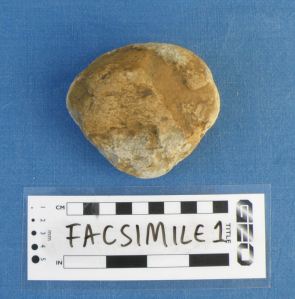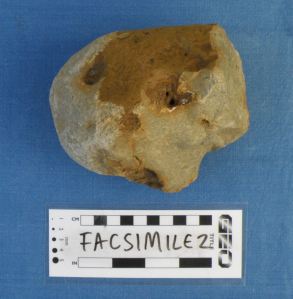I have finished the two facsimile sarsen hammerstones that I was making for the Stonehenge Visitor Centre Education Team.
The smaller hammerstone (Facsimile 1) is an effective pecking stone. A “dimple” in the cortex of the quartzite nodule became part of the stone’s grip; by accident, not design. The larger hammerstone (Facsimile 2) is considerably heavier and has to be held with two hands. It is good for attritional work, removing grains from the surface of a saccaroid sarsen stone. The last thing I did with it before packing it up was to cut a channel along the surface of the stone that I was shaping.
I made these two objects with a mix of “modern” and “prehistoric” techniques: that is, I quickly removed material from each original nodule using some of my iron mason’s tools before finishing them by using them as hammers on saccaroid sarsen. This means that I can’t use data from them in my research to understand how the prehistoric tools got the way we find them. But it is interesting to do the numbers.
As expected, both nodules lost weight as I worked on them. This seems a silly thing to point out. It is important, however, for a number of reasons; not least because archaeologists and curators have tended to describe and present the excavated artefacts as though they all represent the same finished state. Tools change during their life, however, and this change can tell us things about how they were made and used. The small nodule weighed 536g – the hammerstone weighs 444g. The large nodule weighed 2149g – the hammerstone it became weighs 1818g.
It is very difficult to describe the shape of these irregular objects in a meaningful way – a way that can be replicated. When I analysed the Stonehenge hammerstone assemblage (a forthcoming publication), I used a technique developed and used in geology. It makes it possible to document and follow the changing shape of the nodules as they become hammerstones.
The small nodule’s shape was “oblate spheroid”. By the time I had finished, the hammerstone shape still fell into this class, but now at the less elongated and ‘fatter’ end of the scale. This reflects how material was knocked off the circumference of the small nodule, making the tool more rounded than the nodule.
The large nodule’s shape was “sub-equant spheroid”. On completion, the hammerstone shape still fell into the same range of this class. This is a reflection of the blocky shape of the un-worked nodule which I chose specially for this quality; and the way that I concentrated on using one end of the nodule for hammering.
Had I continued using the hammerstones, their weights shapes would have changed. As it is, they are now with the Education Team and will take their place with the rest of the objects in the new handling collection.


